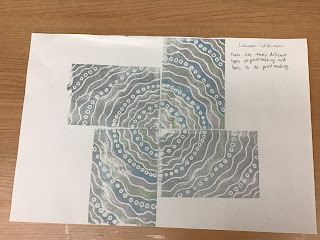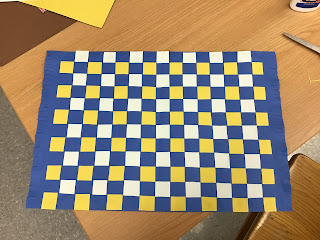
This project is a lesson for using the medium painting. The project is done by first mixing paint to make brown, and then painting the back of two paper plates, one large and one small (or a second large plate cut down to a smaller circle). Why that is drying, students can move to the feather station, where they spray a layer of shaving cream, and then paint is dropped on top of the shaving cream to be swirled around to look like a marble effect. Students then dip a rectangular piece of paper into the shaving cream swirl. After they pull the paper off the shaving cream, they scrape off the excess shaving cream, leaving a marble effect on the paper. After those dry, students can cut out a feather shape. Next, students cut out shapes for the eyes, beak, neck, and feet. Finally, once everything is dry, the students glue everything together. As students work, the teacher has lots of opportunities to teach how to mix paints to achieve the desired color. In addition, shapes, and movement are great areas to talk about with students.
As an extension activity, would be to have a discussion on unity/diversity. Students would be instructed to go on a gallery walk to see everyone else's turkeys. Once everyone has a chance to see all of the turkeys they would sit down to discuss the similarities and differences. As the discussion goes on, I would guide students to seeing that the feathers are different because they all have different swirls, but they are similar because they all have the marble effect. Even though the feathers have different swirls and may have different colors, but they all look super cool. Then, I would lead the discussion to talk about how each of us have differences, but we can all get along because we all have wonderful characteristics, even if those characteristics are different.









